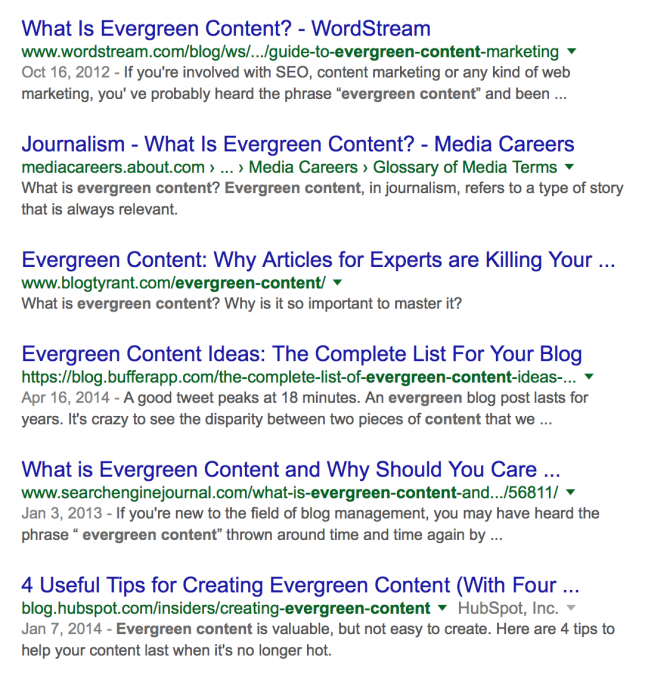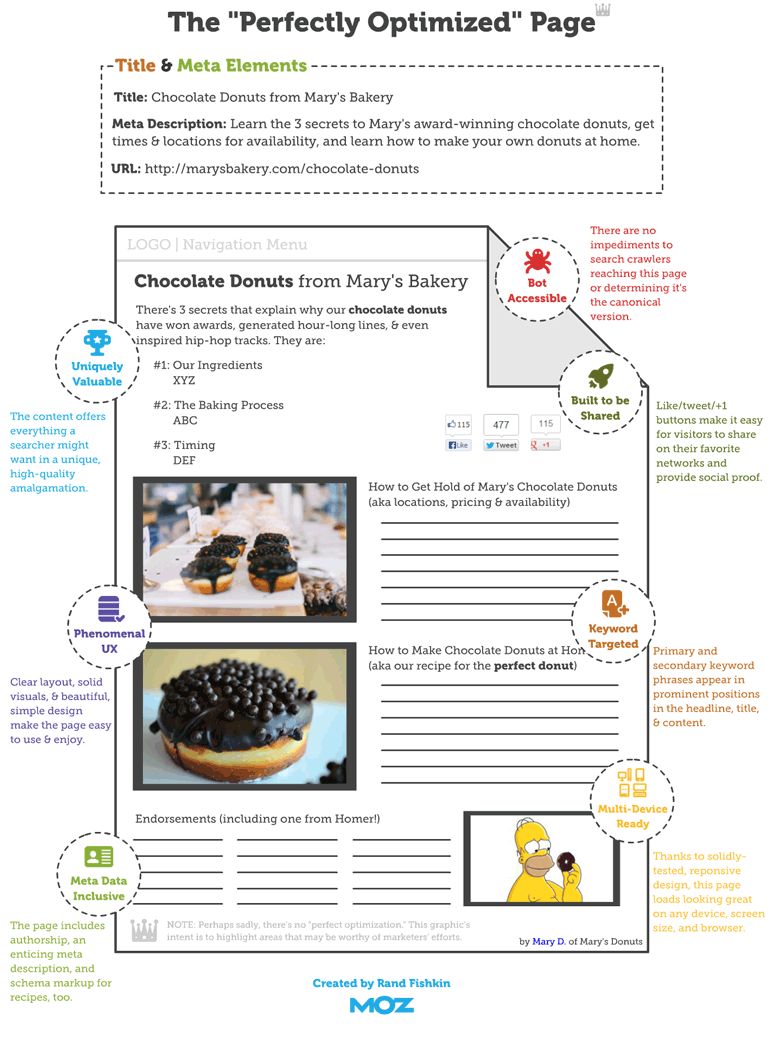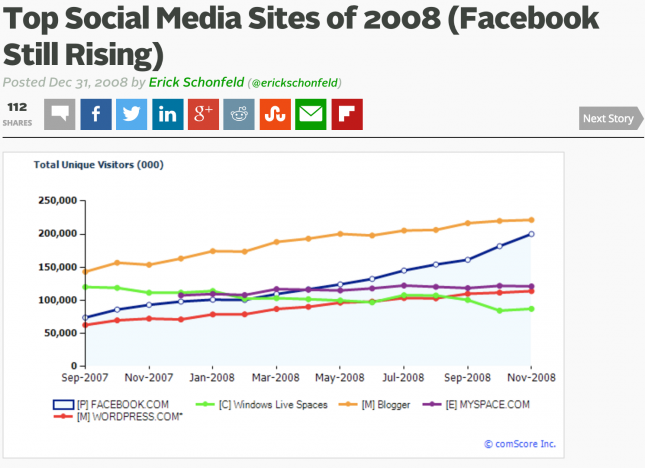Good evergreen content is always relevant to your target market. It may not include information that’s new or trendy, but it should provide good advice, be entertaining, or solve a problem for potential readers. Whether it’s two months or two years old, the best content drives traffic on its own through organic means or ongoing social sharing. As an example, here’s the traffic to one of our best evergreen blog posts:
But sometimes good content doesn’t rise to the top, or it’s not optimized around the right keyword, or it’s hard to discover because it’s buried in your site. Good content that doesn’t catch on may still be relevant and informative, but its traffic over time probably looks more like this:
While there’s no surefire formula to serve up high-performing evergreen material every time, a few best practices will improve your odds. This post will explore a few things you should ask yourself to make sure content that’s worthy gets the results it should:
- Is SEO optimized?
- Does it deliver value to readers?
- Is it still relevant?
- Does it have a strong point of view?
If your evergreen content isn’t getting the traction you want, making sure you’re hitting all four of those points will give it new life.
Optimize it for SEO
Think about what happens when you publish a piece of content. You blast it socially, you put it in an email, you feature it on your blog or website, and if it’s something big, you might even do some PR around it. But what happens when the content scrolls to page two of your blog and people stop tweeting about it?
Well, nothing happens if it’s not SEO optimized. Maybe there’s some referral traffic or maybe people find it within your site, but the content won’t have any ability to drive traffic unless you make an effort to promote it.
The good news is that optimization of existing content doesn’t necessarily take much work. To quickly get a read on how you’re doing, there are two steps to take:
1. Keyword research: Enter the most important words that describe the content in your piece into Google’s Keyword Planner. Using this article as an example, I put the term “evergreen content” into the keyword planner, but didn’t find many interesting variants:
- “evergreen content” gets 590 monthly queries
- “what is evergreen content” gets 110
There were a few other related terms that got under 40 queries per month, but it looks like the only real chance this article has for driving traffic on an ongoing basis is to rank for one of those two terms.
2. Competition check: Look to see if the content that shows up in the existing search results is consistent with what your article is about–and also make sure the content that’s ranking isn’t vastly superior to the content you’ve got. Here’s the top of the current search results:
These look like my content marketing peers, so it makes me feel good about targeting the right audience. What doesn’t make me feel good is the fact that there’s a lot of competition from reputable sites with good authority. Nonetheless, I feel like I’ve got an interesting take and some insights that aren’t in some of those articles, so I’m on the right track.
Once you’ve verified keywords you should be using, the next step is to optimize around them by making sure you’re using them well in your evergreen article. The image below includes all the basics for optimizing around your keyword and its variants (if your keyword was “chocolate doughnuts,” that is). It also includes technical elements you should probably be building into your site, but if you focus on using your keyword the way chocolate doughnuts is used here, you’re well on the way to winning the battle:
For more on-page optimization tips, check out this full article from Moz.
Deliver value in your evergreen content
If your content isn’t performing, you also want to take a look in the mirror and ask yourself whether it’s any good. Be honest with yourself. If it reads like a poor man’s Wikipedia article, it’s probably not something your audience (or Google) is likely to dig.
For example, it would have been easy for me to write this article like this:
What is evergreen content? It’s content that’s perpetually relevant to its readers.
Why do I need evergreen content? Because it makes you more efficient. You can create the content once and reap the benefits forever!
And so on.
That article would’ve met the requirements of the perfectly optimized page infographic above, but would it have been really useful for the reader? Bottom line, content will never be successful if it doesn’t inform, entertain, or help people solve a problem. When someone googles something, they’re looking for an answer. Google’s goal is to give people that answer without having to click around much. Thus, your job when you create evergreen content is to deliver the best answer possible.
If you wouldn’t want to read the content you’re creating, chances are that nobody else will either.
“Quality content is stuff that your audience actually wants to consume and share,” explains Michele Linn, vice president of content at Content Marketing Institute, in an interview with Scripted.com. “But more importantly, quality content is whatever drives the business for your organization.”
Make sure your content is still relevant
Say you did a blog post called “Top Social Media Sites.” You did a bunch of research, you optimized it right, and you delivered value to your reader, but then you let it sit around a few years. This is what you’d have:
A page like this is going to fall out of the rankings because it’s simply not valuable (except as a time capsule–where’s Friendster, by the way?).
A lot of times refreshing a post like this won’t take a lot of work and–especially with a post that has had some success and a bunch of backlinks–it can be a super quick win to bring it up to date.
Develop a point of view
Finally, evergreen content will tend to do better when it has a point of view. This is kind of an extension of making sure it’s both valuable and relevant. When you include a perspective that’s uniquely yours, you’re going to automatically set yourself apart from other people who produce similar content. Your perspective (and the way you share it) can be the value your readers are looking for.
Having a strong point of view will also get people sharing and commenting. It can build an emotional connection that might not otherwise exist in an article titled “The definition of evergreen content.” Blech.
So go forth, update evergreen content that’s lost (or never had) its luster, and then you can prosper.
The post How to Refresh Evergreen Content (and Reach a Big Audience) appeared first on Visually Blog.
from Visually Blog
http://blog.visual.ly/refresh-evergreen-content-new-audience/





No comments:
Post a Comment